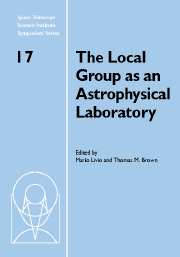 The Local Group as an Astrophysical Laboratory
The Local Group as an Astrophysical Laboratory Book contents
- Frontmatter
- Contents
- Participants
- Preface
- History of the Local Group
- Primordial nucleosynthesis
- Galactic structure
- The Large Magellanic Cloud: Structure and kinematics
- The Local Group as an astrophysical laboratory for massive star feedback
- Hot gas in the Local Group and low-redshift intergalactic medium
- Stages of satellite accretion
- The star formation history in the Andromeda halo
- Bulge populations in the Local Group
- The Local Group as a laboratory for the chemical evolution of galaxies
- Massive stars in the Local Group: Star formation and stellar evolution
- Massive Young Clusters in the Local Group
- Magellanic Cloud planetary nebulae as probes of stellar evolution and populations
- The old globular clusters: Or, life among the ruins
- Chemical evolution models of Local Group galaxies
Bulge populations in the Local Group
Published online by Cambridge University Press: 12 May 2010
- Frontmatter
- Contents
- Participants
- Preface
- History of the Local Group
- Primordial nucleosynthesis
- Galactic structure
- The Large Magellanic Cloud: Structure and kinematics
- The Local Group as an astrophysical laboratory for massive star feedback
- Hot gas in the Local Group and low-redshift intergalactic medium
- Stages of satellite accretion
- The star formation history in the Andromeda halo
- Bulge populations in the Local Group
- The Local Group as a laboratory for the chemical evolution of galaxies
- Massive stars in the Local Group: Star formation and stellar evolution
- Massive Young Clusters in the Local Group
- Magellanic Cloud planetary nebulae as probes of stellar evolution and populations
- The old globular clusters: Or, life among the ruins
- Chemical evolution models of Local Group galaxies
Summary
The spatial resolution and multiwavelength capability of the Hubble Space Telescope has advanced greatly the study of spheroidal populations of galaxies. The main sequence turnoff point of the Galactic bulge has been clearly measured and the proper motions of stars used to separate the foreground disk from the bulge. The study of bulge globular clusters by HST shows that the bulge field population is coeval with the halo. In the obscured Galactic Center, infrared imaging with NICMOS reveals a continuous star formation history. NICMOS imaging of the nucleus of M31 has settled a long standing debate about whether luminous AGB stars (possibly indicative of an intermediate age stellar population) are present. Measurements of the composition from the ground, and of the age from HST, are consistent with a scenario in which spheroidal populations formed very early. HST spectroscopy has also revealed the presence of central black holes in many bulges and spheroids. The formation of the stellar populations and black holes in spheroids was probably one of the earliest events in galaxy formation.
Introduction
The bulge populations of the Local Group are a window in the nearby Universe to some of the most important aspects of galaxy formation: The age (formation epoch) of bulge populations, their metal content, and their coevolution and connection with nuclear black holes. Spheroidal populations (including bulges) account for more than half of the stellar mass at the present epoch (Fukugita, Hogan, & Peebles 1998) and also even at redshift 0.7 (Bell et al. 2004). The connection between nearby and distant bulge populations is not a new revelation.
- Type
- Chapter
- Information
- The Local Group as an Astrophysical LaboratoryProceedings of the Space Telescope Science Institute Symposium, held in Baltimore, Maryland May 5–8, 2003, pp. 127 - 139Publisher: Cambridge University PressPrint publication year: 2006


